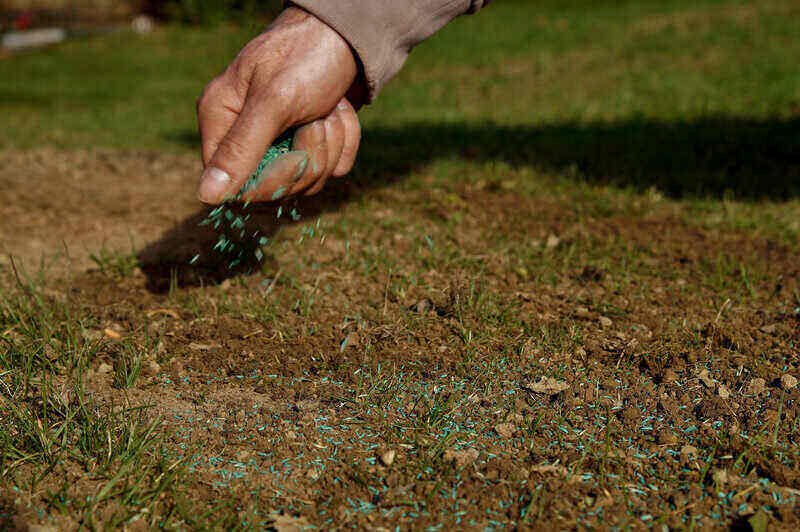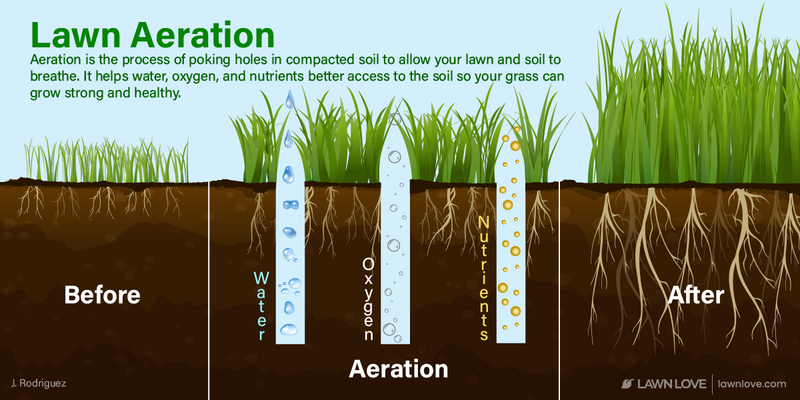
Springtime in Pennsylvania signals the season to declutter and get organized. The same holds true for your lawn. After a long, white winter, it’s time to welcome an emerald lawn. Follow these 12 spring lawn care tips to get your Allentown lawn in great shape.

1. Inspect your equipment
A job well done relies on the proper tools and consistent maintenance of those tools. To maintain a healthy lawn, your gas mower needs to be in tip-top condition:
- Replace or sharpen mower blades
- Change the oil and gas
- Remove all debris from the mower
- Clean or replace air filter
- Install new spark plugs
Pro Tip: If you don’t feel qualified to give your mower a thorough “spring cleaning,” contact a local outdoor equipment/garden retailer.
If you have an electric mower, perform these tasks:
- Check condition of the cord
- Wipe or blow off any debris with a leaf blower or brush
- Sharpen blades, if necessary
- Lube the wheels
- Change the oil
- Check the tires for proper pressure
- Filter might need to be cleaned and/or replaced
- Charge the battery before your mow
Do you use a weed eater? Gas, battery or electric? Doesn’t matter which type is in your shed or garage. A good spring “dust and polish” renders a more efficient tool.
For a gas weed eater:
- Purchase a new filter, if necessary, or give the existing one a good cleaning
- Check the spark plug
- Change the oil
- Add fresh gas
Electric weed eater maintenance tips:
- Check the belt; make sure it’s on properly and secure
- Inspect the cord
- Clean off any debris
Cordless or battery-operated weed eater to-do list:
- Charge the battery
- Wipe off any debris or dirt
- Clean exhausts and intakes
We just listed some basic guidelines for equipment. However, for your particular make or model, check your manual. If you’re unable to locate it, try the company’s website.
In addition, clean and sharpen your pruning shears and other cutting tools. This simple task allows you to easily glide for a precision cut. You’ll discover that even a sharpened shovel digs more easily through soil and roots.

2. Clean the gutters
Before the flow of April showers, strongly consider cleaning out your gutters. They are more than likely clogged with fallen debris from trees. Left undone, the collected rainwater stands stagnant, resulting in possible water damage and flooding. Also, proper maintenance prevents corrosion and the invasion of small animals.
- Wear heavy gloves, safety glasses, long pants and sleeves.
- Use a tarp under the ladder. (Make sure your ladder is strong and steady.)
- Use a small shovel or garden scoop to remove debris.
- After all debris is removed, hose out the spouts.
If you prefer not to take on this task, contact a professional gutter cleaning service.

3. Clean up the yard
Those 29 inches of winter snow dumped on Allentown probably pulled down branches, tree limbs, and twigs. Gently rake and remove all debris. If you leave this heavy carpet on your lawn, it will smother the grass and prevent air, sunlight, water, and nutrients from penetrating the soil.
Damp leaves and debris also trap moisture, creating an ideal breeding ground for fungus such as pink or gray snow mold. While we often hear “pretty in pink,” you definitely do not want those pink patches dotted around your lawn. Pink snow mold enjoys cold, wet conditions but will go dormant in the summer. Other than removing debris, avoid a heavy application of nitrogen.
To prevent gray snow mold, the lawn should have been treated with a fungicide before the winter. Untreated blankets of snow result in mold. However, you can help you lane become healthy with diligent raking and overseeding in the spring.
Creepy critters consider blankets of damp debris a consummate cover to hide. You might find wildlife like mice, rodents, moles, shrews, snakes, and voles.

4. Dethatch your lawn
Thatch is composed of dead, decomposed stems and roots and accumulates between the grass and soil. If left unattended and more than ½ inch thick, this layer decreases the movement of air, water, sunlight, and essential nutrients.
To remove thatch, use a power rake, which can be purchased or rented from your local garden center. However, if your lawn is bigger than the average backyard, you might need to call in a professional who is more experienced and adept at using a coring machine.
Cool-season grasses might require dethatching in early spring or early fall. You can detect if your lawn requires dethatching by slicing out a 3-inch deep piece of your lawn. If it’s spongy or brown, you’ll probably need to dethatch.

5. Test the soil
Healthy soil results in a happy and healthy lawn. In order to make that determination, your soil needs to be tested for the proper levels of acidity and nutrients, namely nitrogen, phosphorus, and potassium.
Before applying fertilizer, obtain a soil sample. You need to ascertain the proper ratio of nutrients required for your lawn.
How to properly take a soil sample:
- Use a shovel or trowel and dig into the soil about 6 inches
- Collect from about a dozen areas throughout the lawn
- Do not collect wet soil
- Fill about a cup with soil
Your Lehigh County Extension Office will help be able to assist you to obtain a test and interpret the results. For more information about how to read your soil test, check out the bulletin, “Interpreting Your Soil Test Results” from PennState Extension.

6. Feed with fertilizer, if necessary
Cool-season grasses tend to grow lusher in the spring, but you need to follow the specific fertilizer recipe provided from your soil test. The test results reveal the proper ratio of nutrients required for your lawn, namely, nitrogen, phosphorus, and potassium. This is referred to as the NPK ratio.
For example, 30-5-10 on a fertilizer bag means it contains 30% nitrogen, 5% phosphorus, and 10% potassium.
You also might want to consider a slow-release nitrogen fertilizer to reduce the possibility of “lawn burn.” To kick-start growth, apply in mid-spring, around late April or early May. The turf will then become resilient and ready to stand up to the warm and humid summer ahead.

7. Apply weed control
Weeds plague lawns and move in as the unwanted inveterate dwellers. However, don’t give up the battle. Help is on the way with a pre-emergent herbicide. Diligently apply in early spring to keep broadleaf weeds and crabgrass from a spring or summer launch.
Weeds already made an appearance? Knock them dead with a post-emergent herbicide.
Pro Tip: Follow these herbicide application precautions:
- Wear protective clothing, including gloves and goggles
- Read the application instructions carefully
- Do not apply on a windy day
- Store containers in a safe place, away from direct sunlight, children and pets
Weeds often “camouflage” as pretty flowers, such as violets and dandelions. However, they need to be controlled for the following reasons:
- Monopolize garden space
- Discourage good plants from thriving
- Gorge on water and other nutrients
- House undesirable insects
Environmentally conscious gardeners might consider corn gluten meal as a non-chemical pre-emergent method. However, the application must happen before weeds germinate.
Post-emergent home remedies include a spray combination of vinegar, dish soap and salt. Of course, there’s always the down and dirty method of removing by hand. This method is somewhat practical for smaller yards, but not feasible for large lawns.

8. Hold off on overseeding
While you could overseed in the spring, cool-season grasses respond more favorably to fall overseeding. Weather conditions, such as soil temperature and moisture level, create a positive atmosphere for growth.
However, if you can’t bear to look at those bald spots on your lawn, go ahead and overseed, using the same cool-season grass already growing in your lawn. Spread the seed in mid-March to early April. But the soil needs preparation and frequent watering even through the summer and fertilization. To prevent weed growth, you’ll also need to apply a pre-emergent herbicide.

9. Get rid of bugs
With the snow now just a distant memory, spring boasts longer days and warmer temperatures. People spend time outdoors and pests awaken from their nests. It’s easy enough to tell a noisy neighbor to “bug off” but invasive insects and bugs aren’t as easily deterred.
When outdoors, follow these preventive tips to warn off mosquito and tick bites:
- Apply sunscreen first; then insect-repellent
- Cover up! Wear socks, long sleeves, long pants
- Use mosquito netting where appropriate, such as a stroller
- Carefully read and follow bug-repellent instructions
Pro Tip: It’s advisable to use EPA-registered repellents only. They have been thoroughly researched for effectiveness and safety.
- Install mosquito traps (keep out of reach for children and pets)
- Repair holes in screen doors, and windows to prevent them getting indoors
- Eliminate standing water, if, where, and when possible
- Change birdbath and pet water bowls often
- Consider plants that repel mosquitoes
Unfortunately, the spotted lanternfly finds Allentown’s backyards are a favorite spot to hang out. This dreaded invader classifies as a serious invasive pest, gnaws hardily on plants, and produces an icky substance that attracts bees and wasps. Subsequently, this “goo” creates a breeding ground for fungi and coats patio furniture, cars, and anything else left outside.
Pro Tip: To reduce the spread of spotted lanternfly goop, continually inspect the exterior surface of your car, outdoor furniture, mower, outdoor grill, and firewood. If your area has been infected, it’s time to act. Immediately contact a pro to stop the flow of this pesky pest.

10. Mow properly
Follow these tips to properly mow your cool-season grass:
- Outside temperature should be consistently 40 degrees before your first mow.
- Do not mow on icy or wet grass. If you insist on mowing grass that hasn’t been thawed, you run the risk of severe damage to the grass.
- Follow the one-third rule. Do not cut off more than one-third of the existing grass blade in one mow. Cutting too much at once causes stress on the lawn and slows root growth.
- Mow at least once every four to seven days.
- Most cool-season grasses should be kept between 2 to 3 inches tall.
You could follow these general guidelines for the individual grasses:
- Fine fescue: 1.5-3 inches
- Tall fescue: 2-4 inches
- Kentucky bluegrass: 2-3 inches
- Perennial ryegrass: 2-3 inches
Remember these are just general guidelines. When in doubt or for a more exact height, contact the Lehigh County Extension Office to determine the specific height for your lawn.

Pro Tip: An easy, inexpensive, and non-time consuming way to maintain healthy grass is to alternate your mowing pattern. If you continually mow in the same direction, your lawn might get marked with tire tracks and grass compaction. Consequently, that opens the possibility of weed encroachment and diseases.

11. Aerate, if necessary
Aeration is a process to alleviate compacted soil by punching holes into the lawn. This technique allows essential nutrients, water, and oxygen to penetrate the soil.
The optimum time to aerate cool-season grasses is the fall. The heat of the summer stresses the soil. Fall aeration assists in root growth and repair. However, if your spring lawn dries out quickly, shows signs of thinning, or looks like a herd of heavy horses galloped through, then go ahead and aerate.

12. Water wisely
In Lehigh County, approximately 21% of rainfall occurs in spring. However, July actually holds the title for the wettest month. Loaded with that info, you need to be cognizant of the amount of rainfall in April and May. Generally, 1 inch of water a week is adequate. As the climate increases, you will need to increase your watering schedule.
Here are some water-wise tips:
- Water in the early morning, between 10 a.m.
- Do not water in the evening; moisture settled on grass can lead to diseases
- Irrigate to about 1-1 ½ inches of water per square foot
- Deep and infrequent watering is recommended
Pro Tip: When in doubt, perform the screwdriver test. If your screwdriver isn’t able to easily dig down 6 to 8 inches, then a good soak is imperative.
Also, keep in mind if your grass is looking unhappy and a bit “blue,” water it!
Put a spring in your step
After you’ve completed the 12 lawn care steps for your lusher Allentown lawn, imagine how fun it will be to walk barefoot in the backyard. And if you need help maintaining your new, healthy lawn, call a professional in Allentown to mow, edge, and fertilize.
Main photo credit: PhotoMIX Company | Pexels